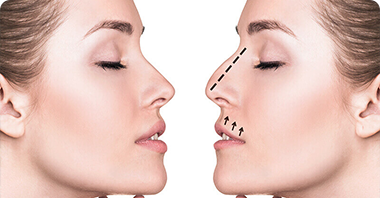

Often known as the “Nose Job”, rhinoplasty is a plastic surgery procedure which involves reshaping, resizing or reconstruction of the nose in order to either enhance esthetics or restore the form and function of the nose. What does a Rhinoplasty procedure do? Types of Rinoplasty Who is the right candidate for a Rhinoplasty? Who is the right person to perform a Rhinoplasty? Pre- surgery precautions The procedure Risks involved in Rhinoplasty What to expect after surgery?
Rhinoplasty involves correction of:
1. Length of the nose
2. Width of the nose
3. A deformity in the tip or bridge of the nose, like drooping tip or visible humps and depressions in the bridge of the nose
4. Shape of the nostrils
5. Nasal blocks due to septal deviation
6. Correction of irregular dorsum e. g. Humps/ deviations
7. Nasal asymmetry
8. Obstruction in airway or breathing
9. Congenital deformities
Reduction Rhinoplasty - this type of rhinoplasty is primarily to alter the size of the nose, correction of width of the nose or a bridge bump, or altering the nostril size and shape to bring them in proportion to the rest of the face.
Augmentation Rhinoplasty – this type involves increasing the dimensions of the nose by adding structural material or grafts for aesthetic and functional enhancement purposes.
Post-traumatic Rhinoplasty – as the name suggests, this type deals with the post- traumatic deformities of the nose, like deviation, asymmetry or even obstruction in airway and breathing.
Ethnic Rhinoplasty - The Ethnic Rhinoplasty takes into consideration the particular nasal characteristics based on the patient’s ethnicity. In a way all of the rhinoplasties can be considered as ethnic rhinoplasties as a special care is always taken towards maintaining the ethnic features of the face while correcting any kind of nasal deformity.
A person can be considered as an ideal candidate for Rhinoplasty if he/she has:
1. Good general health
2. Full grown facial features, except for cases where breathing is impaired and in trauma cases.
3. Any breathing or airway problems
4. Any kind of aesthetic nasal deformity
5. Realistic expectations from the cosmetic treatment
A perfect rhinoplasty is said to be done when post- surgery, people know there is an appealing change but are unable to point at the actual spot. Such an outcome is possible only when surgery is performed by the right person.
A cosmetic surgeon, who has the essential qualification, knowledge, acumen and the experience for doing such a technique sensitive surgery is the ideal person to put one’s trust in. It is not a piece of wardrobe that one can discard if it does not look good. One can play with clothes and colors but not with body parts.
A rhinoplasty must always be considered as any other surgery of the body and requires similar precautions and care from the doctor as well as the patient.
The patient must explain his expectations clearly to the doctor but at the same time keep them realistic.
The preparation for this surgery will also require complete medical history, examination and essential investigations to be conducted.
Photographs may be taken to assessment of existing facial features and comparison post operatively.
Cessation of all certain medication and smoking will be required at least 4 weeks prior to the surgery.
An average procedure takes 2-3 hours except complex or multiple surgeries which may take longer.
It can be done using local or general anesthesia.
Generally done as an OPD/ Day care procedure but may occasionally require hospitalization for a day.
Rhinoplasty can be done as an open procedure where the incision is made outside of the nose across the columella or a closed procedure where the incision hides inside the nose. The incision helps to raise the skin over the nasal bone and cartilage to have access to the desired location that requires alteration.
Depending on the desired result, some bone and cartilage may be removed, or tissue may be added (either from another part of the body or using a synthetic filler). After the surgeon has rearranged and reshaped the bone and cartilage, the skin and tissue is closed over the structure of the nose. A splint is placed outside the nose to support the new shape of the nose as it heals.
Rhinoplasty carries the same risks as any other surgery. Bleeding, infection, and reactions to medications or anesthesia are possible side effects of rhinoplasty surgery. Rarely one might need a second procedure at some point in the future to rearrange the tissues this is especially true in cleft deformities corrected at younger age as the nose tends to grow with age.
Similar to any other surgery, rhinoplasty also requires good post op care. Generally it takes about 2 weeks to heal completely even though the patient can resume his daily activities within 4-5 days.
Mild pain, and discomfort is common after the surgery and can be controlled by medication.. Black eyes are not unusual especially after bony reshaping.
Swelling and discoloration in the operated area can remain for few days which can be minimized with cold compression.